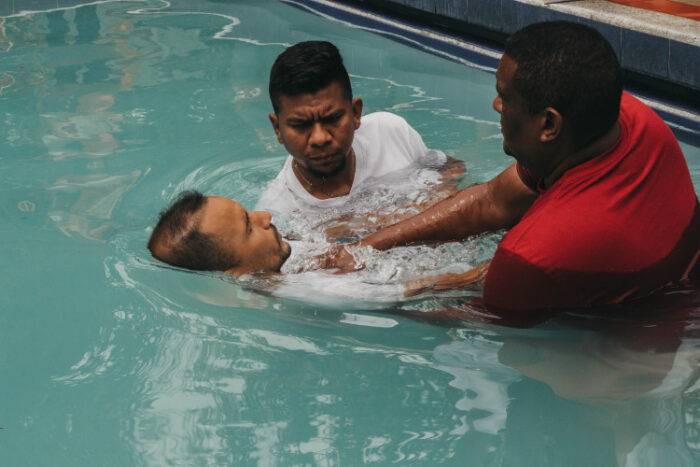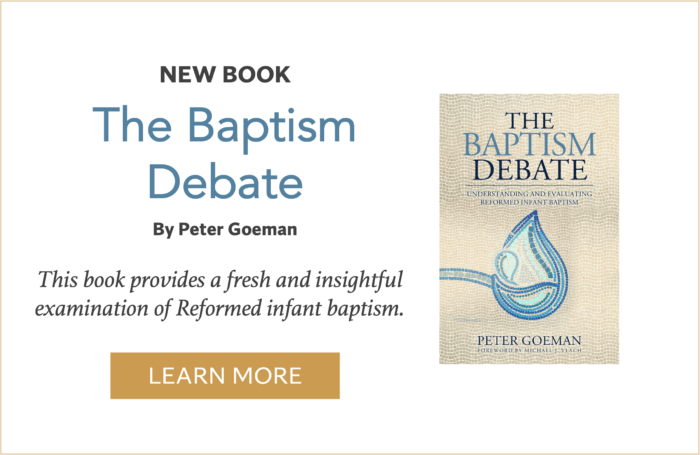Immersion in the Early Church Baptismal Practice
Those who argue for infant baptism often appeal to church history as evidence that infant baptism was a regular church practice. Although infant baptism was indeed practiced by the time we get to the end of the 3rd century, prior to that time there are significant questions regarding the regularity of the practice. Furthermore, although modern paedobaptists will often appeal to church history for defense of paedobaptism, they often ignore the early church testimony on the regularity of immersion. In other words, the early church sources are clear that immersion was the regular mode of baptism for those in the church, and deviations from that practice were viewed as exceptional.

Immersion in the Didache
One of the earliest sources we have on baptism is from the Didache (7:1–4). Although a lot could be said about the Didache, here I want to emphasize that this early church source emphasizes immersion. Consider how the Didache describes baptism:
Concerning baptism, baptize in this way: after you have reviewed all these things, baptize into the name of the Father and of the Son and of the Holy Spirit in running water. If you do not have running water, baptize in some other water. If you are not able [to baptize] in cold water, then in warm water. If you have neither, pour water upon the head three times in the name of the Father and Son and Holy Spirit. Prior to baptism, let the one who baptizes and the baptizand fast, and others if they are able. Instruct the baptizand to fast one or two days beforehand.
Translation from Wilhite, The Didache, xxxvii.
There are a variety of observations that help us here. First, the location of the baptism is in the water (like the New Testament picture). It was to be in “running water” (i.e., flowing water like a river). However, cold water was permissible if there was no running water, and warm water was permissible if neither running nor cold water was available. Importantly, these instructions only make sense if one is to be immersed or dipped in the water, because they would have to be standing in water.
Another important observation is that pouring water on the head three times was viewed as an exception. This exception was in contrast to the normal process of baptism. If pouring water on the head was the normal process of baptism, why would the author list it as an exception to be practiced only if there was insufficient water?
Tertullian on Baptism by Immersion
Tertullian was a prolific Latin author of the early third century, and he produced the most extensive early writings on baptism that we have. Most people know of Tertullian because he provides the first undisputed evidence that the early church practiced infant baptism during his time. It should be noted that, although Tertullian mentions infant baptism, it is highly debatable whether that was viewed as the norm since he seems to speak against infant baptism. Although that is an interesting topic, for our purposes, Tertullian also gives powerful testimony that immersion was the practice of the church during his time. He writes:
After His resurrection He promises in a pledge to His disciples that He will send them the promise of His Father; and lastly, He commands them to baptize into the Father and the Son and the Holy Ghost, not into a unipersonal God. And indeed it is not once only, but three times, that we are immersed into the Three Persons, at each several mention of Their names.
Tertullian, “Against Praxeas,” in Latin Christianity, 623.
Similarly, elsewhere Tertullian writes:
To deal with this matter briefly, I shall begin with baptism. When we are going to enter the water, but a little before, in the presence of the congregation and under the hand of the president, we solemnly profess that we disown the devil, and his pomp, and his angels. Hereupon we are thrice immersed, making a somewhat ampler pledge than the Lord has appointed in the Gospel.
Tertullian, “The Chaplet, or De Corona,” in Latin Christianity, 94.
In both texts, Tertullian says that the Christians practiced immersion three times (once for each member of the Trinity). Tertullian’s testimony is also important because he is writing in Latin. Thus, he is a very early testimony, describing baptism as immersion in a language other than Greek.
Cyprian on Sprinkling as an Exception for the Sick
Another Latin father, Cyprian, provides helpful insight into the issue, but from a unique angle. In his Epistle to Magnus (LXXV), Cyprian discusses how Christians should think about those who are too weak or sick to be baptized by the normal process:
You have asked also, dearest son, what I thought of those who obtain God’s grace in sickness and weakness, whether they are to be accounted legitimate Christians, for that they are not to be washed, but sprinkled, with the saving water. In this point, my diffidence and modesty prejudges none, so as to prevent any from feeling what he thinks right, and from doing what he feels to be right. As far as my poor understanding conceives it, I think that the divine benefits can in no respect be mutilated and weakened; nor can anything less occur in that case, where, with full and entire faith both of the giver and receiver, is accepted what is drawn from the divine gifts. For in the sacrament of salvation the contagion of sins is not in such wise washed away, as the filth of the skin and of the body is washed away in the carnal and ordinary washing, as that there should be need of saltpetre and other appliances also, and a bath and a basin wherewith this vile body must be washed and purified. Otherwise is the breast of the believer washed; otherwise is the mind of man purified by the merit of faith. In the sacraments of salvation, when necessity compels, and God bestows His mercy, the divine methods confer the whole benefit on believers; nor ought it to trouble any one that sick people seem to be sprinkled or affused, when they obtain the Lord’s grace …
Cyprian of Carthage, “The Epistles of Cyprian,” in Fathers of the Third Century, 400–401.
The important takeaway of Cyprian’s text is that it was exceptional to sprinkle or practice affusion in his day. Cyprian makes a difference between the normal washing that Christians undergo in baptism, and the sprinkling which weak or sick Christians undergo. Like the Didache, Cyprian believed it was appropriate to allow sprinkling or affusion when someone could not practice normal baptism by immersion.
Leo the Great and the Symbolism of Immersion
Another helpful confirmation of the early church’s practice of immersion comes from Leo I. Also known as Leo the Great, Leo I was bishop of Rome from 440 to 461 AD. In his argument for why baptisms should occur on Easter, he writes the following (Letter 16.4):
As the blessed Apostle says: “Are ye ignorant that all we who were baptized in Christ Jesus, were baptized in His death? We were buried with Him through baptism into death; that as Christ rose from the dead through the glory of the Father, so we also should walk in newness of life. For if we have become united with the likeness of His death, we shall be also (with the likeness) of His resurrections,” and the rest which the Teacher of the Gentiles discusses further in recommending the sacrament of baptism: that it might be seen from the spirit of this doctrine that that is the day, and that the time chosen for regenerating the sons of men and adopting them among the sons of God, on which by a mystical symbolism and form, what is done in the limbs coincides with what was done in the Head Himself, for in the baptismal office death ensues through the slaying of sin, and threefold immersion imitates the lying in the tomb three days, and the raising out of the water is like Him that rose again from the tomb.
Leo the Great, “Letters,” in Leo the Great, Gregory the Great, 28. Emphasis added.
Leo provides another reference to threefold immersion, and we also have a clear connection to the biblical theology of Romans 6. Leo argues for the typical Baptist understanding of Romans 6. Namely, that the baptismal picture of immersion corresponds with Christ’s death, and the raising up of Christ in resurrection corresponds with the raising up out of the water.
The quotations above are just a sampling of the many early church sources that support the idea that immersion was the main practice of the early church. The evidence that the early church practiced baptism through immersion is overwhelming. Lexicography, biblical description, and church history all point to this reality. In fact, historically, paedobaptists have also recognized this to be the case. I leave you with a quote from John Calvin on this issue:
But whether the person being baptized should be wholly immersed, and whether thrice or once, whether he should only be sprinkled with poured water—these details are of no importance, but ought to be optional to churches according to the diversity of countries. Yet the word “baptize” means to immerse, and it is clear that the rite of immersion was observed in the ancient church.
John Calvin, Institutes of the Christian Religion, 1320. Emphasis added.
So, if baptism through immersion was the practice of the ancient church, and it is the meaning of the word “baptize,” why do some churches not practice immersion? That is a good question.
